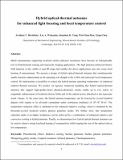| dc.contributor.author | Boriskina, Svetlana V | |
| dc.contributor.author | Weinstein, Lee Adragon | |
| dc.contributor.author | Tong, Jonathan K. | |
| dc.contributor.author | Hsu, Wei-Chun | |
| dc.contributor.author | Chen, Gang | |
| dc.date.accessioned | 2017-08-17T17:57:07Z | |
| dc.date.available | 2017-08-17T17:57:07Z | |
| dc.date.issued | 2016-09 | |
| dc.date.submitted | 2016-05 | |
| dc.identifier.issn | 2330-4022 | |
| dc.identifier.uri | http://hdl.handle.net/1721.1/110971 | |
| dc.description.abstract | Metal nanoantennas supporting localized surface plasmon resonances have become an indispensable tool in bio(chemical) sensing and nanoscale imaging applications. The high plasmon-enhanced electric field intensity in the visible or near-IR range that enables the above applications may also cause local heating of nanoantennas. We present a design of hybrid optical–thermal antennas that simultaneously enable intensity enhancement at the operating wavelength in the visible and nanoscale local temperature control. We demonstrate a possibility to reduce the hybrid antenna operating temperature via enhanced infrared thermal emission. We predict via rigorous numerical modeling that hybrid optical–thermal antennas that support high-quality-factor photonic-plasmonic modes enable up to 2 orders of magnitude enhancement of localized electric fields and of the optical power absorbed in the nanoscale metal volume. At the same time, the hybrid antenna temperature can be lowered by several hundred degrees with respect to its all-metal counterpart under continuous irradiance of 10⁴–10⁵ W/m². The temperature reduction effect is attributed to the enhanced radiative cooling, which is mediated by the thermally excited localized surface phonon polariton modes. We further show that temperature reduction under even higher irradiances can be achieved by a combination of enhanced radiative and convective cooling in hybrid antennas. Finally, we demonstrate how hybrid optical–thermal antennas can be used to achieve strong localized heating of nanoparticles while keeping the rest of the optical chip at low temperature. | en_US |
| dc.description.sponsorship | United States. Department of Energy (DE-FG02-02ER45977) | en_US |
| dc.language.iso | en_US | |
| dc.publisher | American Chemical Society (ACS) | en_US |
| dc.relation.isversionof | http://dx.doi.org/10.1021/acsphotonics.6b00374 | en_US |
| dc.rights | Article is made available in accordance with the publisher's policy and may be subject to US copyright law. Please refer to the publisher's site for terms of use. | en_US |
| dc.source | Svetlana V. Boriskina | en_US |
| dc.title | Hybrid Optical–Thermal Antennas for Enhanced Light Focusing and Local Temperature Control | en_US |
| dc.type | Article | en_US |
| dc.identifier.citation | Boriskina, Svetlana V. et al. “Hybrid Optical–Thermal Antennas for Enhanced Light Focusing and Local Temperature Control.” ACS Photonics 3, 9 (September 2016): 1714–1722 © 2016 American Chemical Society | en_US |
| dc.contributor.department | Massachusetts Institute of Technology. Department of Mechanical Engineering | en_US |
| dc.contributor.approver | Boriskina, Svetlana V. | en_US |
| dc.contributor.mitauthor | Boriskina, Svetlana V | |
| dc.contributor.mitauthor | Weinstein, Lee Adragon | |
| dc.contributor.mitauthor | Tong, Jonathan K. | |
| dc.contributor.mitauthor | Hsu, Wei-Chun | |
| dc.contributor.mitauthor | Chen, Gang | |
| dc.relation.journal | ACS Photonics | en_US |
| dc.eprint.version | Author's final manuscript | en_US |
| dc.type.uri | http://purl.org/eprint/type/JournalArticle | en_US |
| eprint.status | http://purl.org/eprint/status/PeerReviewed | en_US |
| dspace.orderedauthors | Boriskina, Svetlana V.; Weinstein, Lee A.; Tong, Jonathan K.; Hsu, Wei-Chun; Chen, Gang | en_US |
| dspace.embargo.terms | N | en_US |
| dc.identifier.orcid | https://orcid.org/0000-0001-8917-7547 | |
| dc.identifier.orcid | https://orcid.org/0000-0002-3973-8067 | |
| dc.identifier.orcid | https://orcid.org/0000-0001-8121-8017 | |
| dc.identifier.orcid | https://orcid.org/0000-0002-3968-8530 | |
| mit.license | PUBLISHER_POLICY | en_US |
| mit.metadata.status | Complete | |
